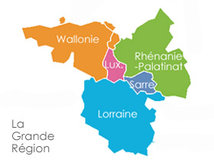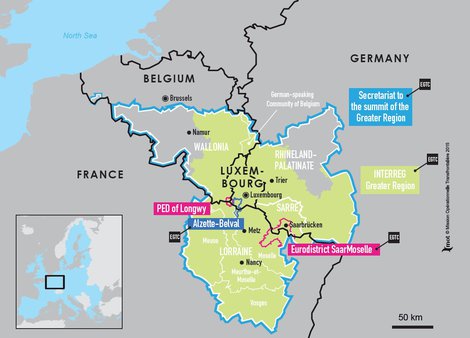Greater Region
Countries: Germany , Belgium , France , LuxembourgRegions concerned: France – Lorraine region;
Germany – states of Saarland and Rhineland-Palatinate;
Belgium – Walloon region, French and German-speaking communities of Belgium;
Grand Duchy of Luxembourg
Introduction
The Greater Region (Grande Région) stretches over 65,000 km2 and brings together German, French and Belgian territories as well as the Grand Duchy of Luxembourg. It benefits from a strategic geographical cross-border location and a considerable economic potential.
An interregional cooperation structure established in 1995, it enables the development of cooperation between the four states, whose borders are marked by high volume flows of border workers. Its strategy aims to respond to the needs of the population within the cross-border territory, while developing its competitiveness.
The cooperation area
Situated at the heart of Europe, the “Greater Region” brings together the German federal states of Saarland, Rhineland-Palatinate, the Lorraine region in France, the Walloon region, the French and German communities of Belgium and the Grand Duchy of Luxembourg. With a surface area of 65, 401 km2, the cross-border region comprises 11.3 million inhabitants, of whom 1,960,000 are border workers.
This territory is marked both by a great diversity and common challenges. It is characterised by a common labour market and constantly growing cross-border mobility.
Organisation and dynamics of the territory
The Grand Duchy of Luxembourg is a driving force of cross-border cooperation in the Greater Region, representing its economic heart of international dimensions. It constitutes the main centre of attraction in terms of cross-border labour: 3,700 border workers in 1960, and 150,000 in 2012 (including 75,000 from Lorraine) – or 40 times more.
Given this situation, Luxembourg considers the Greater Region as its development space of reference, and is committed accordingly, as since 2009, cross-border cooperation is followed by the Ministry for the Interior of Luxembourg. The Walloon region, Saarland and Rhineland-Palatinate are also fully implicated in this dynamic, as is the Conseil regional of Lorraine, which created a “Greater Region mission” in 2012 in order to give a cross-border dimension to its regional spatial planning strategy.
The move to cooperation
Although the idea of a space for dialogue appeared in the 1980s, the first summit of the Greater Region was held only in 1995, on the initiative of the Luxembourgish Prime minister, and the Minister-president of Saarland. A joint declaration, signed on the occasion, made it possible to initiate a framework for cooperation by institutionalising the organisation of regular summits of the Greater Region, notably permitting updates on the different fields of cooperation (economy, transport, research, tourism, education, spatial planning and development).
With the impetus provided by the European Union, the objective is to construct an integrated economic and social space with a total surface area of 65,000 km2 (twice the size of Belgium) and to develop actions at a larger scale than local cross-border cooperation.



